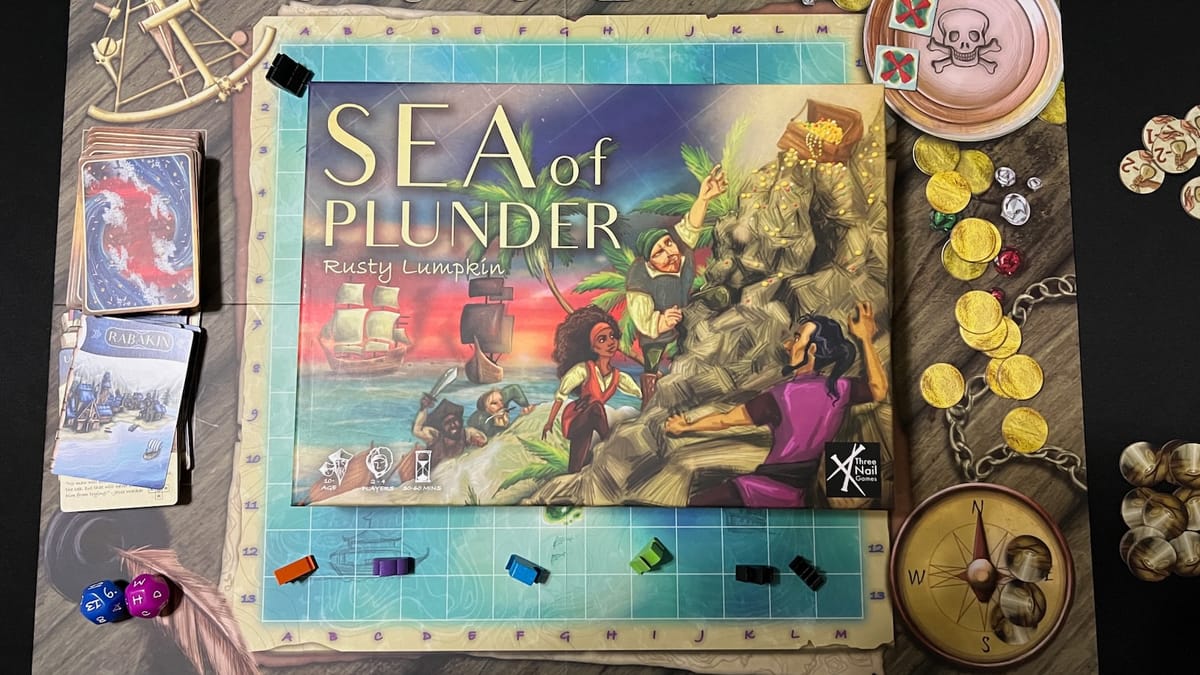
At the 2023 Origins Game Fair, I was able to meet a friendly board game creator named Rusty Lumpkin, owner of Three Nail Games. A teacher and a family man, Rusty wanted to create engaging gateway games that could be used in classrooms and played with his children. One of the games that caught my eye was Sea of Plunder, a pirate adventure game where players try to outmaneuver unsavory sailors, the worst, sometimes being the other players.
Sea of Plunder is a game for 2-4 players where players take control of a pirate ship with a goal of finding hidden treasure and collecting sets of goods from various ports around the board. Throughout the game, players will play cards to move their ships in unique patterns while avoiding interactions with other players and one of the four pirate ships lurking around the seas. After one of two end game conditions is met, players will calculate their scores with the highest score sailing away with the victory.
Overview
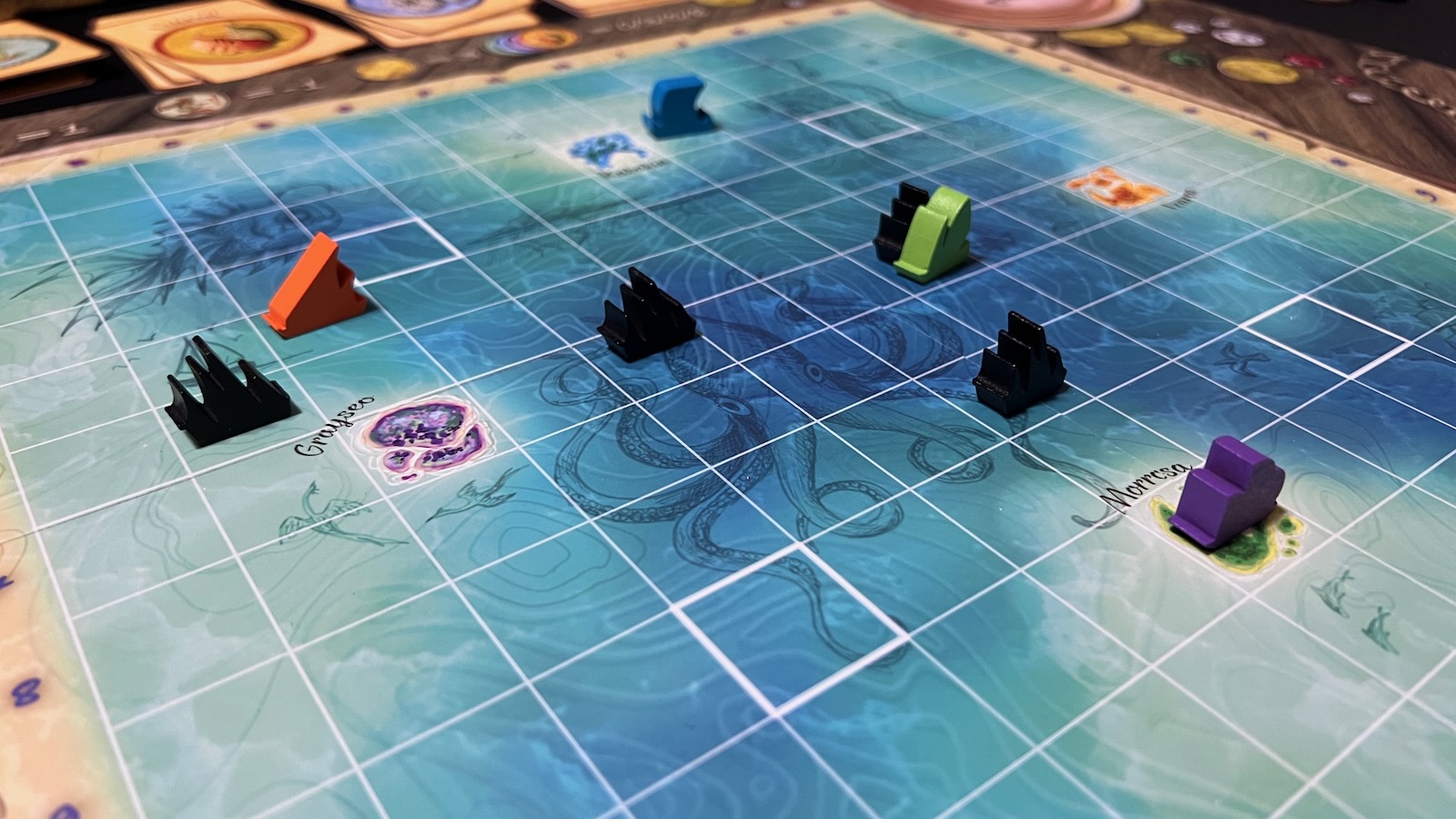
At the start of the game, players will pick one of four brightly colored ships to control and place them on a matching island. Each of these islands also has a corresponding trade good that players will draw to their starting hands. Pirate ships will be placed on four starting positions surrounding the islands and a treasure island will be placed in the middle of the board. Players will then receive a number of cards from the draw pile to complete their starting hands. Players will also receive a double sided, male/female, role card with a special ability they can use throughout the game.
There are a number of different card types in the game.
- Event Cards: These cards have a red border. After players draw cards on their turn, they will then complete the steps listed on any that were drawn.
- Action Cards: These cards have a red header. These cards, when used from a player’s hand, have a variety of effects that include moving treasure islands, giving debt tokens, and the ability to draw more cards.
- Goods Cards: These cards are picked up by visiting one of the four port islands. Players will score different point values by collecting sets of different colored cards at the end of the game. There are only four of each goods card, so attacking other players or influencing pirates may be necessary to get cards when depleted.
- Map Cards: These cards allow players to move their ships around the board. Players use the orientation of the compass on the board to orient their cards and must use the exact movement. If players discard a magic compass, they may orient the card in any way they’d like.
- Port Island Cards: When played, these cards allow players to move ships directly to the island shown on the card.
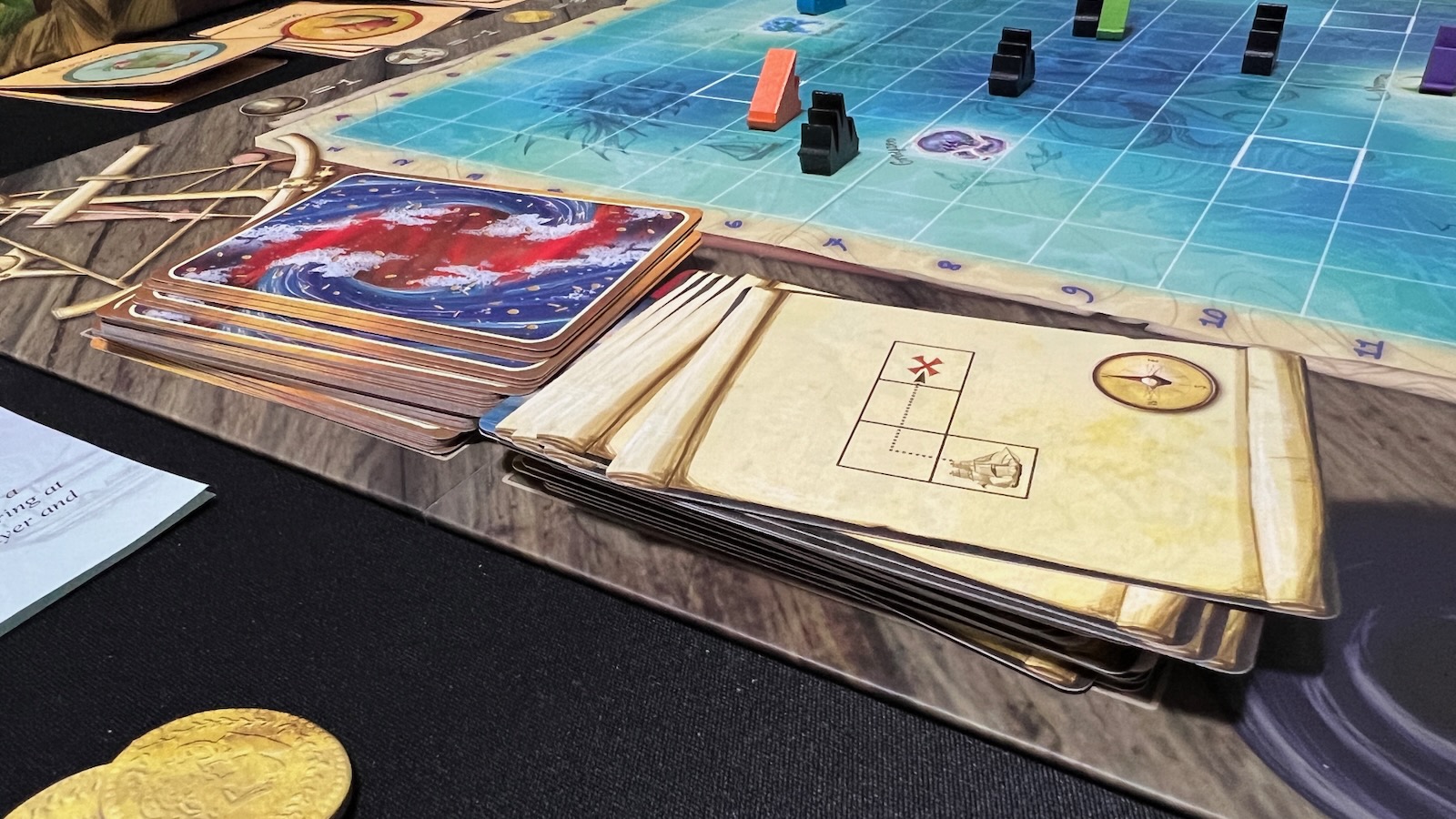
A player’s turn takes place in three phases. In phase one, players will draw two cards, either from the top of the deck or in combination with the top card of the discard. If an event card is drawn, players will set these to the side until two non-event cards are drawn. They will then execute the actions on the event cards, if any. In the next phase, players will play one of the cards from their hands and execute the actions. In the final phase, players will discard another card from their hand to move a pirate ship. Different cards will move the pirates in specific ways.
- Map Cards move the ships in the same way as player ships.
- Action cards will move ships according to the printed directions in the corner of the card.
- Port cards will move a selected pirate ship to the port depicted. Ports with pirate ships cannot be visited by player ships.
Through their movements, player and pirate ships will interact with each other and various islands around the board.
- When passing over a treasure island, or if an island passes over a ship, players and pirates will collect a treasure token. If a player lands directly on a treasure island, they will also draw a card. After collecting treasure, two included dice are rolled indicating the new location of the treasure island.
- If a player ship moves over another, the moving player will draw a card from the deck. If a player lands directly on another player, they will steal a card randomly from the other player’s hand.
- If a player comes into contact with a pirate ship, they will have to discard one goods card back to its stack. If the player cannot, they will take one debt token.
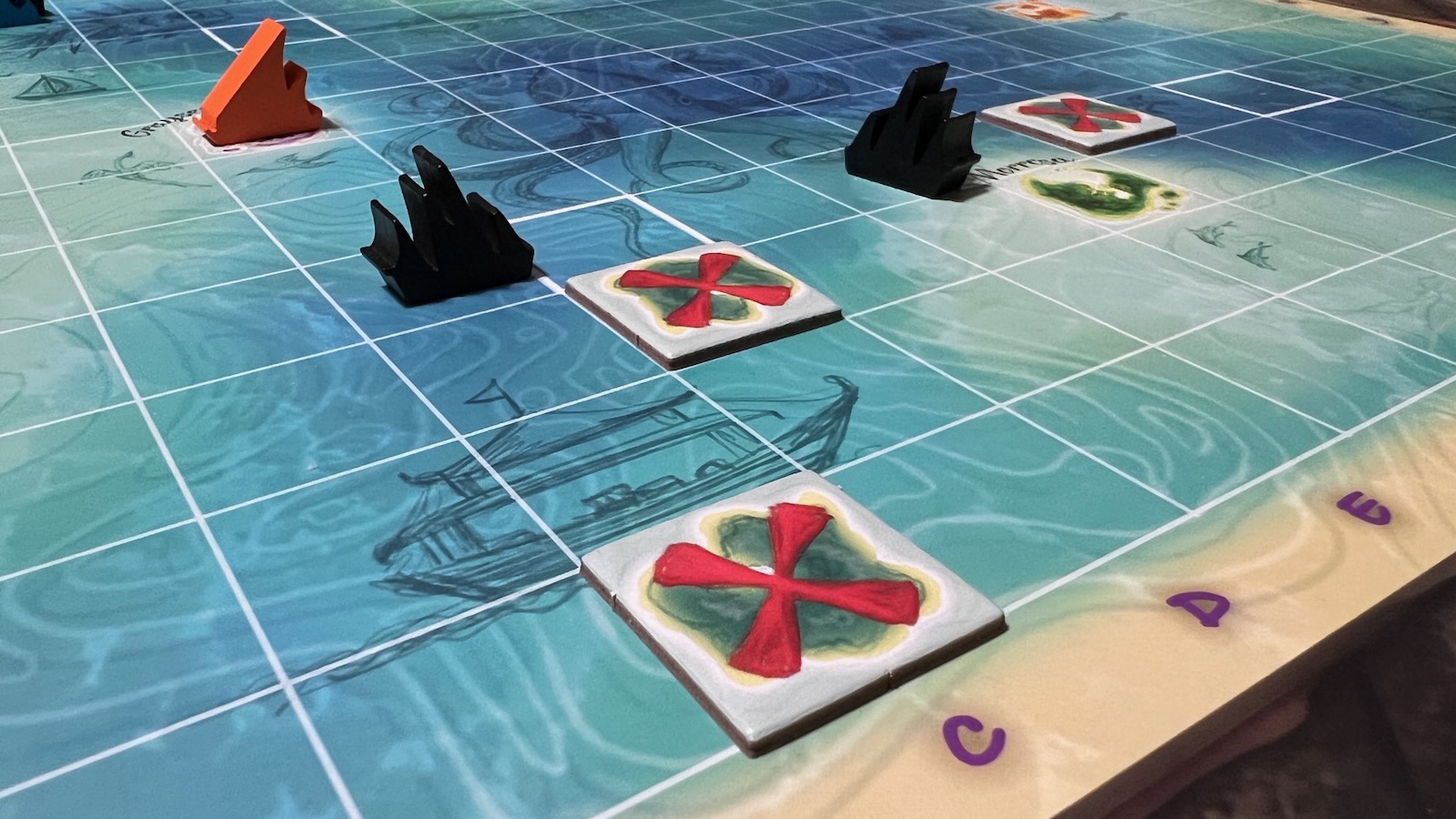
Turns will continue from player to player until one of two conditions are met. The first is when one player has collected three or more treasure tokens. The second is when the pirates have collected six or more treasures. When triggered, the current round is finished and then final scoring is calculated. Each treasure is worth three points, unused magic compasses are worth a point a piece, debt tokens are worth negative points, and sets of different goods cards are worth an increasing amount of points. The player with the most points wins.
Variants

The game comes with two different variants and an optional module. The two-player variant has players controlling two different color ships. On their turn, players will choose one of their two boats to move, but are not allowed to move both. On the opposite side of the board, a blank map is printed. Players can use tiles to randomly place the four Port Island tokens and the four pirate ships on the board. The Combo Port Island Module allows players to add another port island token to the board by rolling the dice where any goods card can be collected.
Production
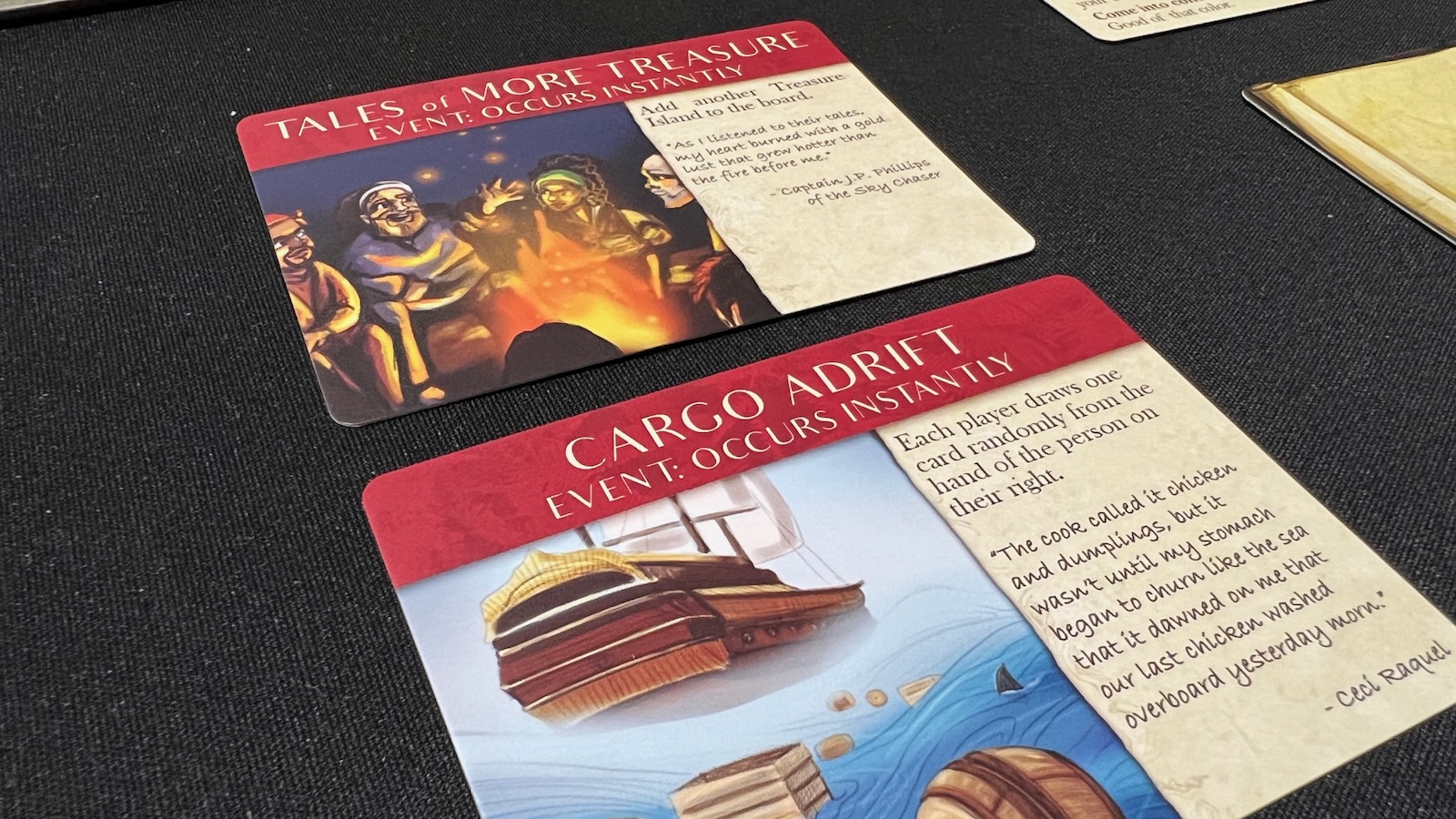
The entire game has a vibrant hand drawn aesthetic that draws your attention from the illustrations on the cover of the box, to the color palette on the cards and the board. The cards are of a nice quality and are easy to discern the different types of cards with the use of color and orientation of the text. The port islands, their associated goods cards, and the starting player ships are vibrant colors that one does not see in many games. The layout of the board feels like the game is being played on a map laid out in the quarters of one of the ships. The pirate ships have their own dark mystery to their color and shape and each player ship is crafted in a different style to further denote the differences between players. The rulebook is fairly easy to follow and feels like the only piece that could have used a little more time in the design phase. The font used felt very anti-thematic as you read through the book.
Gameplay

I wasn’t expecting a lot from this game when I first got it to the table. The rules seemed rudimentary and I was skeptical about the strategy. I was, however, pleasantly surprised! While pretty simple to grasp the concepts of the game, the execution of getting to your goals was challenging. When playing with others who understood that plundering the seas was not a passive quest, you had to outmaneuver players, pirates, and whatever else the game threw your way. Having to play map cards using the orientation of the compass and not being able to turn them without spending a magic compass, meant you had to strategically think about how to get to an objective. Using pirate ships to block other player goals or even strategically move them through other players’ ships had some devastating effects to a players own strategy. Using action cards at a strategic moment could give a player a big boost when it seemed like they were down and out. The whole game felt, to me, like a game of pirate chess. Throughout my plays of the game, I kept thinking of how much my middle school students and family members would like the game and latch on to it easily.
My biggest complaint about the game is that, for a game about pirates, it doesn’t seem cutthroat enough. All of the event cards were mostly positive, giving players cards, tokens, or adding more treasure islands to the board. Adding in some more random events that had some pirate-y decisions or even some ill effects could be fun. Most of the negative effects came from event cards, but even then did not seem all that bad, other than receiving a debt token or two. I guess this is coming from a core gamer who likes a little misfortune to work around a time or two.
Sea of Plunder
Great
Overall, this game is a family friendly pirate game with some fun decision spaces in what and how you play cards from your hand. The game has some great aesthetics. While it may not make it to my table very often, I think this will be a great game to get my younger nephews to the table and teach them about planning strategies and may a little cutthroat pirate sensibilities.
Pros
- Great aesthetics throughout the game
- Easy to learn and some fun strategy
- A great teaching tool for upper elementary/middle school age students
Cons
- Not cutthroat enough for a pirate game
- Some more variety in certain card types
- More family and less core gamer
